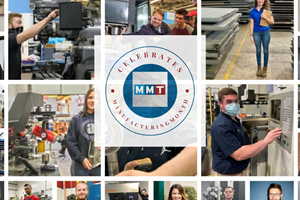Keeping Up with ISO: Applying Total Quality to Sales
Applying the principles of ISO 9001:2015 and the activities of total quality management (TQM) to sales processes can improve the daily operations of any manufacturing facility.
Applying the principles of ISO 9001:2015 and the activities of total quality management (TQM) to sales processes can improve the daily operations of any manufacturing facility.
TQM describes a management approach to long-term success through customer satisfaction in which all members of a company participate in improving processes, products, services and the culture in which they work. The ISO 9001 standard includes references to TQM activities such as advanced product quality planning, production part approval process, failure modes and effects analysis, and statistical process control.
Customer satisfaction and feedback are the cornerstone and driving force behind a TQM program. If customers find that your widgets are just a tad undersized, the TQM philosophy dictates that you find a way to widen the widgets. TQM protocols allow you to apply fact-based customer responses to building a better product for a better profit.
ISO 9001:2015 is based on the principle that every staff member must be committed to maintaining high standards of work in every aspect of a company’s operations. Total quality management means just that—total, from inception through customer fulfillment. The trail of information surrounding a business transaction starts with the salesperson discovering or anticipating a customer need. It ends with the salesperson monitoring customer satisfaction and working toward raising it to customer delight. In many companies, that critical information trail can account for 80 percent of the cost of poor quality (white-collar rework, wrong price quotation, product warranty, excess inventory, cash impact, cost margin, accounts receivable, costly shipping, overtime). The other 20 percent is attributed to blue-collar rework, scrap and field rework.
Many companies initially focus on product quality, or the quality of manufacturing operations. It’s been referred to as quality in the box. They come to recognize, however, the critical need to move beyond that singular mindset to a holistic approach that encompasses all business processes. A fundamental cornerstone is the belief that people inside the company build internal customer/supplier partnerships in order to satisfy and delight their external customers.
The first rule of a growth-oriented sales strategy is to consider satisfied customers your primary source of new business. The second rule is to seek greater market share by locating new customers in the same markets as your current customers. Following these rules to build your sales strategy takes time and practice. Let’s look at a few ways to get started:
Find a niche. Although most industry segments have similar quality requirements, each segment has its own set of policies, procedures and practices. Have you ever wondered why so many moldmakers that serve the automotive industry do so almost exclusively? Or why molders choose not to serve that niche? Essentially, those that serve the automotive market have become very proficient at meeting automotive requirements. They know all the red tape and paperwork required, the quality criteria, and the ins and outs of working with the Big Three, or the Japanese or European automakers.
Selling to potential customers with requirements similar to those of your current customers is simply easier and less costly than trying to penetrate unfamiliar markets. If you’re already skilled at building molds that mold clear crystal styrene parts for the packaging industry, search for other industries that use clear crystal styrene components. Perhaps you excel in parts with high-end cosmetic requirements. Find similar parts that call for high cosmetics.
Create a niche for yourself, and excel at the skills and expertise that fit that niche. Position yourself at the top of your niche so that the competition finds it either too difficult or too expensive to compete with you.
Sell value. ISO 9001:2015 provides five methods for helping you define how your company adds value.
1. Obtain management commitment. Establish a total-quality committee, chaired by the CEO/owner, that focuses on pressing issues.
2. Attain 100-percent customer satisfaction. Create a customer advisory team that implements actions to create win-win partnerships.
3. Hire leading-edge people. Use outside and inside training by sector/industry-specific experts.
4. Strive for win-win supplier relationships. Promote awareness that suppliers are partners by using TQM tools such as 5S, 8D and risk analysis. Training to ensure confidentiality and intellectual property protection is also recommended.
5. Set internal goals and strategies. Broaden the base of services to capture a higher percentage of each customer’s business. Diversify into manufacturing and/or fabrication to vertically integrate the company’s offerings. Establish a more selective product line based on each supplier’s willingness and ability to participate in the TQM process and to be competitive in price, delivery, and after-sale support.
Optimize outside sales calls. Put together a list of viable companies in the same city or region, then plan your sales calls to maximize your time. This means scheduling your calls by estimating in advance how much time each will take. In some cases, you may be able to schedule five or six calls a day. Other times, only two or three are manageable. However, be sure you know where you’re going and why you’re seeing someone before you leave for the call.
Preplanning sales trips and making appointments with the correct contacts at each customer and potential customer facility will help your team become more efficient in sales. Although chances are good that you’ll come across a company that you are not familiar with and will want to make a trip, your main purpose must be to see the companies that you have prequalified.
Plan for follow-up. Maximizing sales efforts also means having a good follow-up plan in place. Once a face-to-face visit has taken place, some kind of subsequent contact keeps your company’s name in the forefront of the potential customer’s mind. You always want to send a simple “thank you” letter after a personal visit, followed by systematic contact of some type. This can require the assistance of an inside salesperson.
Another way to promote your company is to work the press for free publicity. Get your name in relevant reports, newsletters and press releases to the trade press. Focus on the markets you want to serve, and personalize letters to customers and potential customers, informing them of any added capabilities, plant expansions or new personnel. As you qualify prospects, add them to your database.
Manage quotes. Once information has been exchanged between you and potential customers, it’s time to determine which leads have tooling and molding requirements that offer good opportunities for immediate business and which ones are more long-term.
An occasional RFQ may come in as a result of your initial contact. However, be wary of the engineer, purchasing agent or materials manager who on the first call says, “Yes! I need a good moldmaker, and I’ve got some parts I want you to quote.” You may think it’s a coincidence that you called just as they needed a good moldmaker, but that may be far from the truth.
For example, say a molder supplies a quote to an OEM that, as it turns out, was involved in an ugly lawsuit with a current molder. This OEM was so skeptical of custom molders that before it would award any business, the molder had to sign a contract stating that if the OEM wanted to pull the molds for any reason, and the molder didn’t release them immediately, the molder would be subjected to a fine of $110,000 per hour. Suddenly, this pot of gold doesn’t look so good to the molder.
Build relationships. Numerous resources are available to help salespeople excel in their jobs, but selling in moldmaking and molding is quite different. Moldmakers and molders are not selling a product, they are relationship-selling. This mean your salespeople must always have the customer’s interests at heart. Only when customers believe that you are trying to satisfy their needs will they build a relationship with you.
A salesperson’s job is to learn why customers and potential customers work with the competition. If you’re asked for an order, and the job is given to a competitor, ask what that competitor provided that you did not. This information will be extremely helpful when the next job comes up for a quote.
Minimizing the cost of each sales call to maximize efforts requires a marketing strategy, good planning and knowing your target. Use a sales strategy that follows your company’s marketing strategy, and your business will grow in the right direction with the right customers.
Related Content
Women Impacting Moldmaking
Honoring female makers, innovators and leaders who are influencing our industry's future.
Read MoreMMT Chats: Marketing’s Impact on Mold Manufacturing
Kelly Kasner, Director of Sales and Marketing for Michiana Global Mold (MGM) talks about the benefits her marketing and advertising, MGM’s China partnership and the next-generation skills gap. This episode is brought to you by ISCAR with New Ideas for Machining Intelligently.
Read MoreMaking Quick and Easy Kaizen Work for Your Shop
Within each person is unlimited creative potential to improve shop operations.
Read More2021 30 Under 30 Honors Program: Mentoring in the Next-Generation of Moldmaking Professionals
Young professionals are vital to the moldmaking industry, and it is important to acknowledge those making strides in shaping the industry's future. MoldMaking Technology recognizes the industry's young talent through its 30 Under 30 Honors Program.
Read MoreRead Next
Keeping Up with ISO: Minimize Risk in Value-Chain Partnerships
In addition to ISO 9001:2015 certification, there are a variety of ways that U.S. manufacturers can lower product-quality risks.
Read MoreHow to Use Continuing Education to Remain Competitive in Moldmaking
Continued training helps moldmakers make tooling decisions and properly use the latest cutting tool to efficiently machine high-quality molds.
Read MoreHow to Use Strategic Planning Tools, Data to Manage the Human Side of Business
Q&A with Marion Wells, MMT EAB member and founder of Human Asset Management.
Read More.jpg;maxWidth=970;quality=90)









_300x250 3.png;maxWidth=300;quality=90)




.jpg;maxWidth=300;quality=90)













